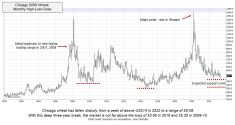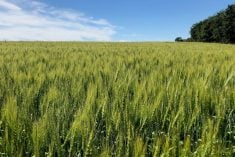Editor’s note: This market analysis was mostly-prepared before the impact of the Russian invasion into Ukraine. As a result, many global commodities are in sway due to a multitude of unforeseen circumstances now in play.
Statistics Canada released its Dec. 31 Stocks Report last month. This report is important because it confirms the production estimate and provides an estimate for the volume of supplies farmers have sold in a certain timeframe, which is useful for projecting basis and timing of sales.
Quick look
Soybeans: Ontario basis levels expect to remain firm with on-farm stocks down.
Corn: A seasonal corn rally is expected in April.
Wheat: Ontario wheat prices diverged from world values due to the tighter on farm stocks.
Read Also

Drones a tool for earlier cover crop planting
Drones are a tool that can help with cover crop planting in still-growing corn and soybeans.
At the time of writing this article, Russian forces were in the process of invading Ukraine. The Ukraine military had suspended operations at port terminals.
Wars tend to enhance inflationary pressures and alter trade flows. There is uncertainty how Western sanctions will influence fertilizer, energy and grain prices.
Markets tend to overshoot to the upside. Secondly, there is a flight to safety in the currency markets resulting in a weaker Canadian dollar. We’re viewing this currency weakness and rally in the grains and oilseeds as a selling opportunity.
The year-over-year increase in Brazilian corn exports will largely offset lower exports from Ukraine and Russia. This event has the largest influence on the wheat complex because Russia and Ukraine have 30 per cent market share of wheat exports.
According to Statistics Canada, Ontario farmers produced 9.5 million tonnes of corn during the 2021 growing season and sold 6.2 million tonnes in the first four months of the corn crop year. Ontario farmers produced 4.1 million tonnes of soybeans and sold 2.9 million tonnes during the first four months of the crop year. At the time of writing this article, Ontario corn and soybean were at 52-week highs. We expect corn and soybean supplies at the end of the 2021/22 crop year to drop to historical low levels.

Ontario corn and soybean basis levels are expected to remain firm moving forward. Ontario wheat farmers have sold the bulk of their wheat. Ontario farmers planted 930,0300 acres of winter wheat this past fall, down 200,000 acres from last year. Given the aggressive sales pace in the first half of the crop year, producers can be patient to make additional sales. However, it’s prudent to start forward sales for new crop positions.
We believe the soybean market has put in the seasonal high. The Brazilian soybean harvest is over 50 per cent complete and exports are in full swing. The Argentinean soybean harvest will be widespread during last week of March. Weather is becoming less of an issue moving forward for soybeans. The corn market tends to make a seasonal high during April when Brazil’s Safrinha corn crop moves through pollination. Traders will focus on U.S. acreage estimates throughout March.
At this stage, we’re looking for a minor year-over-year decrease in corn acres and a modest year-over-year increase in soybean acres. Fertilizer prices are at least twice as high as last year. Supplies could be limited in some areas if farmers didn’t book early.
The Canadian dollar was under pressure during the first two months of 2022. Poor economic data and political issues set a negative tone for the resource-based currency. The exchange rate is expected to strengthen in April and May as GDP numbers improve and supply chain bottlenecks slowly unwind. Export demand will remain strong for all metals, oil and all major commodities as the world moves through a major expansion following the Omicron variant. After each COVID-19 wave, there is a surge in economic output.
Soybeans
Soybean stocks on Ontario farms as of Dec. 31 were 1.14 million tonnes, down marginally from the year-ago level of 1.19 million tonnes. Ontario soybean stocks in commercial positions were estimated at one million tonnes, down about 300,000 tonnes from last year. Stocks on farm and in commercial positions were below year-ago levels as of Dec. 31. Basis levels are expected to be firm moving forward. Exports have slowed and the domestic crushers are showing stronger values compared to elevator bids for offshore movement.
While domestic basis levels are firm, the futures market is expected to grind lower moving forward. The market has factored in lower production estimates from South America. Precipitation in Argentina and Brazil will have less market influence. The USDA had Brazilian output at 134 million tonnes on the February WASDE report. Trade estimates range from 122 to 135 million tonnes. Argentinian soybean production was estimated at 45 million tonnes by the USDA. Private trade estimates have Argentinean output in the range of 38 to 42 million tonnes. Given the higher prices for soybeans and overall net returns per acre, U.S. soybean acreage is expected to be up 1.5 million acres over last year. The market is functioning to encourage production. The Western Cornbelt is on the drier side but normal conditions materialize, we expect U.S. soybean output will be up from year-ago levels.
What to do: We’ve advised Ontario farmers to be 90 per cent sold on their 2021 production. This week, we’re advising producers to sell their first increment of their expected 2022 crop. We generally like to have 20 per cent of the crop sold prior to harvest but at this stage, let’s sell 10 to 15 per cent of expected production as a start. At the time of writing this article, new crop prices were just under $18/bu. We know Ontario farmers sell the bulk of their crop in the first part of the crop year and basis levels will deteriorate moving forward. The soybean futures have significant downside potential.
Corn
Corn supplies on Ontario farms was above year-ago levels while commercials had more ownership compared to year-ago levels. Stocks of corn on Ontario farms as of Dec. 31 were 4.301 million tonnes, down from the year-ago levels of 4.95 million tonnes. Ontario corn stocks in commercial position as of Dec. 31 were 3.884 million tonnes, up 922,000 tonnes from last year. We mentioned in the past that ethanol producers, feedlot operators and exporters have their nearby demand covered which has weighed on domestic basis levels. This weak basis level environment will continue into the spring timeframe.
Corn futures and world cash values will experience a seasonal rally during April. March is the main harvest period for the Argentinean corn crop. The USDA had the Argentinean corn crop at 54 million tonnes. Private estimates are a bit higher than last month due to timely rains. Trade forecasts are hovering around 49 to 50 million tonnes, similar to last year’s output of 50.5 million tonnes.
Brazil’s first corn crop is estimated at 21 to 22 million tonnes, down from last year’s first crop of 26 million tonnes and the harvest is basically wrapped up. Brazil’s second corn crop known as the ‘Safrinha’ production is in the process of being planted. The crop will move through pollination in April and May. The second crop is forecasted to come in around 92 million tonnes given current acreage estimates. We still have the main growing season ahead of us.
U.S. farmers are expected to plant 92 million acres of corn this spring, down from the 2021 planted area of 93.3 million acres. The U.S. corn market will be more sensitive to weather given the year-over-year decline in acreage. The market cannot afford a crop problem or the carryout for 2022/23 becomes extremely tight. The corn market will incorporate a risk premium during April and first half May. The futures will only come under pressure in May after the Safrinha yield is more certain and the U.S. corn crop is planted and developing under favourable conditions.
What to do: We’ve advised farmers to be 70 per cent sold on their 2021 production. This week, we’re advising farmers to sell another 15 per cent bringing total sales for 2021 to 85 per cent. We’ll make our next corn sale in April. Ontario basis levels are stronger and the corn futures will be making seasonal highs during April. In early May, we’ll make our first sale for new crop. Similar to soybeans, farmers should sell a small portion of new crop prior to harvest because Ontario farmers sell the bulk of the crop during the first four months of the crop year which weighs on the basis. This week, we’re advising farmers to sell their first 10 per cent increment of their expected 2022 production. U.S. farmers sell regular increments of corn throughout the crop year. There is no real surge of U.S. farmer selling at harvest unless it’s a big crop.
Wheat
Ontario on-farm wheat stocks as of Dec. 31, 2021 were 350,000 tonnes, down from 400,000 tonnes on Dec. 31, 2020. At the time of writing this article, the Chicago wheat futures were US80 cents/bu off the November highs; however, Ontario wheat prices were at or near 52-week highs. Basis levels have strengthened as on-farm stocks have decreased. Secondly, we can say that Ontario wheat prices have divorced from world values due to the tighter on farm stocks. The function of the wheat market is to ration demand until new crop comes available. Ontario wheat prices need to trade high enough to curb exports and enhance farmer selling. We’re projecting Ontario 2022 winter wheat production to come in at 1.9 million tonnes, down form the 2021 output of 2.7 million tonnes.
Ontario farmers sold 2.55 million tonnes of wheat (winter and spring) from Aug. 1 through Dec. 1. Total Ontario what production was 2.81 million tonnes. This includes 142,500 tonnes of spring wheat and 2.672 million tonnes of winter wheat.
Wheat is one crop for which you need to have sufficient storage. U.S. winter wheat farmers sell 50 per cent of their wheat during the summer months. Ontario farmers sell a large portion in the fall which is good time. There is also potential for a seasonal rally in late winter or early spring as we’ve seen this year.
The U.S. hard red winter wheat region is on the drier side and timely rains will be needed in April. This is typically when the Southern Plains receive seasonal rains. Germany, France, Ukraine and Russia are in good shape so far. Western Canada and North Dakota have recovered from the drought. The cooling of the Pacific Ocean commonly known as ‘La Nina’ tends to result in below normal temperatures and above normal precipitation in Western Canada and North Dakota.
What to do: This week, we’re advising farmers to sell an additional 15 per cent of their 2021 production bringing total sales to 85 per cent. We’ll save the final 15 per cent of stocks in case adverse conditions develop in Kansas in April. If normal rainfall is in the forecast next month for the Southern Plains, we’ll advise Ontario farmers to finish sales. Don’t hold wheat stocks into new crop positions.













